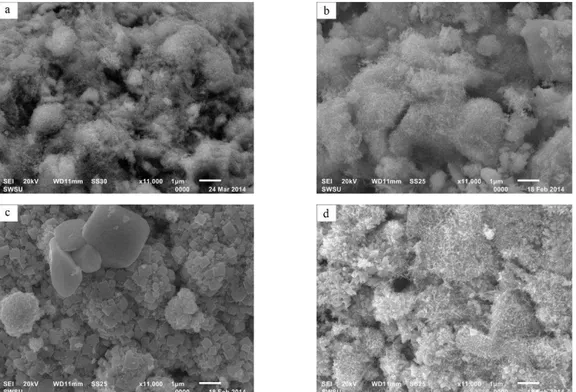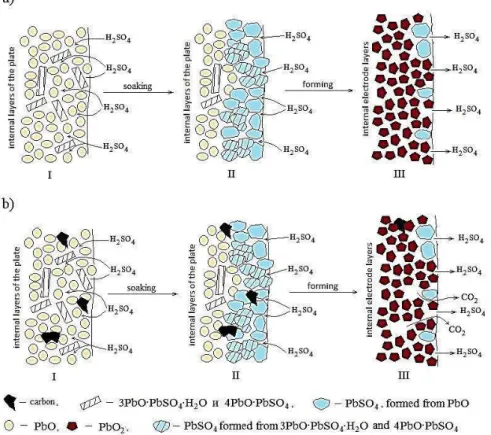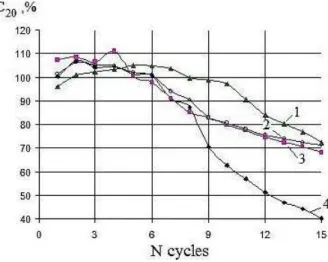J
OURNAL OFN
ANO-
ANDE
LECTRONICP
HYSICS Р А А-
А РVol.
6
No 3, 03028(4pp) (2014)
Том
6
№
3, 03028(4cc) (2014)
The article was reported at the International Conference «The Advanced Technology, Equipment and Analytical Systems for Materials», Kursk, 13-14 May, 2014
2077-6772/2014/6(3)03028(4)
03028-1
2014
Sumy State University
Influence of Electroconductive Additives in the Positive Electrode Material on Morphology,
Structure and Characteristics of the Lead-acid Batteries
A.P. Kuzmenko
1, E.A. Grechushnikov
1, V.A. Kharseev, M.B. Dobromyslov
21
South-West State University, 94, 50 let Oktyabrya Str., 305040 Kursk, Russia
2
Pacific National University, 136, Tihkhookeanskaya Str., Khabarovsk, Russia
(Received 19 May 2014; published online 15 July 2014)
The influence of carbon black, red lead and polyaniline additives on the structure and functional char-acteristics of automotive lead-acid batteries has been studied. The mechanisms contributing to the for-mation both of lead dioxide by the introduction of these additives and of additional conductive nanostruc-tured cross-linking channels in the case of polyaniline are described.
Keywords: Carbon black, Polyaniline, Red lead, Lead-acid batteries, X-ray phase analysis, Scanning elec-tron microscopy, Nanostructuring of active material.
PACS numbers: 61.10. – i, 61.72.Ff
1.
INTRODUCTION
In operation of lead-acid storage cells (LASCs)
com-pounds with dielectric properties can form. For
exam-ple, at discharge the active material of electrodes is
transformed into lead sulphate, which complicates
cur-rent collection from active material and charging of a
lead-acid battery (LAB) [1].
To remove undesirable effects related to the
pres-ence of compounds with dielectric properties and also to
improve the electric characteristics of LABs in
opera-tion at partial-state-of-charge various electroconducting
additives (EAs) [1, 2] are introduced into electrode
ma-terial (EM).
The present work is devoted to studing behaviour of
EAs of various chemical nature in the positive EM and
their influence on the structure of formed active
mate-rial (AM) and electrical parameters of LABs.
In experiments LAB with the following EAs in
posi-tive acposi-tive material were investigated:
1. Low-active carbon black of P803 grade, which
was obtained at thermal oxidation of liquid
carbohy-drate material;
2. Red lead of grade M-4 (92.8 % of lead
orthoplum-bate (Pb
3O
4) by weight) obtained by thermooxidation of
lead oxide;
3. Polyaniline (PANI) of a needle shape of PA-N35
grade obtained from aniline and ammonium persulphate.
2.
EXPERIMENTAL SECTION
EM was prepared according to conventional
tech-nology from highly-oxidized lead powder (76-78 % PbO)
obtained by milling technique and aqueous solution of
sulfuric acid with density of 1.4 g/cm
3. Formation of
LAB was done with pulsed modes of charge in water
baths. To make comparable analysis EM was prepared
without any additives that made it possible to establish
the mechanisms responsible for the structural changes
of electrodes and changes of LAB electrical parameters.
3.
RESULTS AND DISCUSSION
Fig. 1 presents a structure of various
electroconduc-tive addielectroconduc-tives used in the experiments.
Fig. 2 shows influence of the electroconductive
addi-tives on nanostructuring of the positive electrode active
material. The difference in the active material
struc-ture may be related to various mechanisms of the
addi-tives action.
When carbon black was added to positive paste the
morphological composition of samples was not distinct
in general from sample composition without additives
and had tribasic lead sulfate 3PbO∙PbSO4∙H2
O and lead
oxide
α
-PbO as major components [2, 3]. During
soak-ing of lead paste in H
2SO
4solution before formation
when there were no additives a reduction in lead paste
porosity and a change in medium pH were observed [1].
Carbon bla
а
ck added to the positive lead paste had a
critical effect on the AM formation only at LABs
for-mation after soaking.
Carbon black agglomerates consisting of
nanoparti-cles (Fig. 1a)
at LASC formation causes the following
physical, chemical, and electric processes [1]:
1. Adsorption of H
2SO
4at the soaking stage in
buff-er regime [5];
2. Increase in electroconductivity in spite of the
crystals of lead sulfate presence, which were formed at
the soaking stage (Fig. 3, b-II), and also acceleration of
positive electrode formation;
3. Both increase in electroconductivity at the initial
stages and its reduction beginning from the second
stage of formation (Fig. 3, b-III) due to the increase in
porosity of AM because of oxidation of basic amounts of
carbon black nanoparticles. It is this mechanism of
car-bon black effect that may be associated with an
in-crease in the cycle life of LASC that was reported
be-fore in [2, 3].
Red lead represents a lead compound capable to
in-teract with H
2SO
4during paste preparation
Pb
3O
4+
2
2SO
4→
2PbSO
4+ -PbO
2+
2(1)
A.P. K
UZMENKO,
E.A. G
RECHUSHNIKOV,
V.A. K
HARSEEV,
M.B. D
OBROMYSLOVJ.
N
ANO-
E
LECTRON.
P
HYS.
6
, 03028 (2014)
03028-2
a
b
c
Fig. 1 – Structure of electroconducting additives: а – carbon black agglomerate consisting of nanoparticles, b – red lead, с – polyaniline
Fig. 2 –Nanostructure of positive active material containing various electroconducting additives: a – without additives, b – car-bon black, c – red lead, d – polyaniline
In the case of lead paste with additive of Pb
3O
4in
reac-tion (1) two molecules of lead sulfate and one molecule of
lead dioxide with molar volumes of 48.2 and 24.86 g/cm
3,
respectively, are formed [1]. Therefore, red lead with a
molar volume of 75.3 g/cm
3, in our view, was decomposed
under the influence of electrolyte with an increase in
vol-ume and compaction of neighboring electrode materials.
Such compaction was accompanied by the reduction of
porosity in areas where particles of Pb
3O
4were situated
and, as a consequence, diffusion of electrolyte into the
inner paste layers was slow (Fig. 4, b-II).
Lead dioxide is a semiconductor of
n-type with
spe-cific conductivity of 11000 Ohm
– 1∙cm
– 1[1].
Penetrat-ing between the lead sulfate crystals like carbon does it
favors the band formation with increased electric
con-ductivity (Fig. 4, b-II). Accumulation of lead dioxide
molecules that are the crystallization centers speeds up
the AM formation process.
Another case is with PANI, which is a polymer with
semiconducting properties and depending on medium
may exists in various forms and has different
proper-ties (Fig. 5) [4]. For the experiment the most stable
protonated emeraldine form of PANI was used as
nee-dle-shape particles with an average diameter of 8
m
and a length of 60-80
m whose specific conductivity,
according to manufacturer, was up to 2.7 S/cm, and
surface resistance
–
4 Ohm/cm
2. Since amount of the
lead powder was several times that of H
2SO
4intro-duced into the reactor the reactive medium in general
was slightly alkaline [1]. Under such conditions
depro-tonation of PANI may occur and its transition to the
form with a reduced specific electroconductivity [4].
XPA of the lead paste with presence of PANI revealed
that the major components of such paste were tribasic
lead sulfate 3PbO∙PbSO
4∙H
2O and lead oxide α
-PbO.
I
NFLUENCE OFE
LECTROCONDUCTIVEA
DDITIVES…
J.
N
ANO-
E
LECTRON.
P
HYS.
6
, 03028 (2014)
03028-3
Fig. 3 – Stages of structural changes in forming LASC: a – without additives in the lead paste; b – with 1 % additive of carbon (I – dried lead paste after maturation , II –lead paste after impregnation in a solution of sulfuric acid, III – positive active mass after formation)
A.P. K
UZMENKO,
E.A. G
RECHUSHNIKOV,
V.A. K
HARSEEV,
M.B. D
OBROMYSLOVJ.
N
ANO-
E
LECTRON.
P
HYS.
6
, 03028 (2014)
03028-4
Fig. 5 – Structural formulae of PANI various forms: a – protonated emeraldin (initial), b – deprotonated emeraldin (alkaline), c – protonated pernigraniline (oxidized)
Fig. 6 – Dynamics of changes of AB rated capacitance with various additives at cycling (one cycle corresponds to current discharge during 20 h and test by dry run current at – 18 °С): 1 – PANI (1.1 %), 2 – technical carbon (1 %), 3 – red lead (16 %), 4 – without additive
After that dissociated H
2SO
4penetrates into the
surface and middle layers of the electrode plate making
medium acidic. The protonation-deprotonation of PANI
is a reversible process [4]. However, H
2SO
4ions have
no time to reach inner layers of the electrode plate and
PANI situated in that layers is left in a deprotonated
form with relatively low electroconductivity (Fig 4,
a-II). When LAB is charged at first neighboring to the
grid layers of the lead paste are formed. As the current
flows within layers of positive AM the electrode
poten-tial increases gradually. In such conditions PANI is
capable to oxidize and turn into pernigraniline form
(Fig.4, a-III) with specific electroconductivity between
protonated and deprotonated emeraldine [4] but
never-theless by several orders of magnitude less than
specif-ic conductivity of PbO
2. In addition it was found that in
the presence of polyaniline electric current promotes
formation of plain crystals covered by a net consisting
nanofibres of 35-45 nm thick.
4.
CONCLUSIONS
Thus the investigations of EAs effect on functional
characteristics of LAB have shown that carbon black
additive enhances porosity of the positive AM and
cy-cling life of the battery, red lead increases the initial
capacity, PANI also increases cycling life of LAB up to
two times due to the formation of current-conducting
cross-linking nanostructure.
REFERENCES
1. D. Pavlov, Lead-acid batteries: Science and technology. A handbook of lead acid battery technology and its influence on the product. First edition (Elsevier science: 2011). 2. A.P. Kuzmenko, E.A. Grechushnikov, V.A. Kharseev,
In-formation-measuring, diagnostic and controlling systems, 122 (2013) [In Russian].
3. A.P. Kuzmenko, E.A. Grechushnikov, V.A. Kharseev, Fu-ture of Science 3, 303 (2013) [In Russian].
4. M.E. Kompan, I.Yu. Sapurina, V. Babayan, N.E. Kazantseva, Phys. Solid State54 No 12, 2400 (2012). 5. J. Xiang, P. Ding, H. Zhang, X. Wu, J. Chen, Y. Yang,
J. Power Sources241, 150 (2013).


